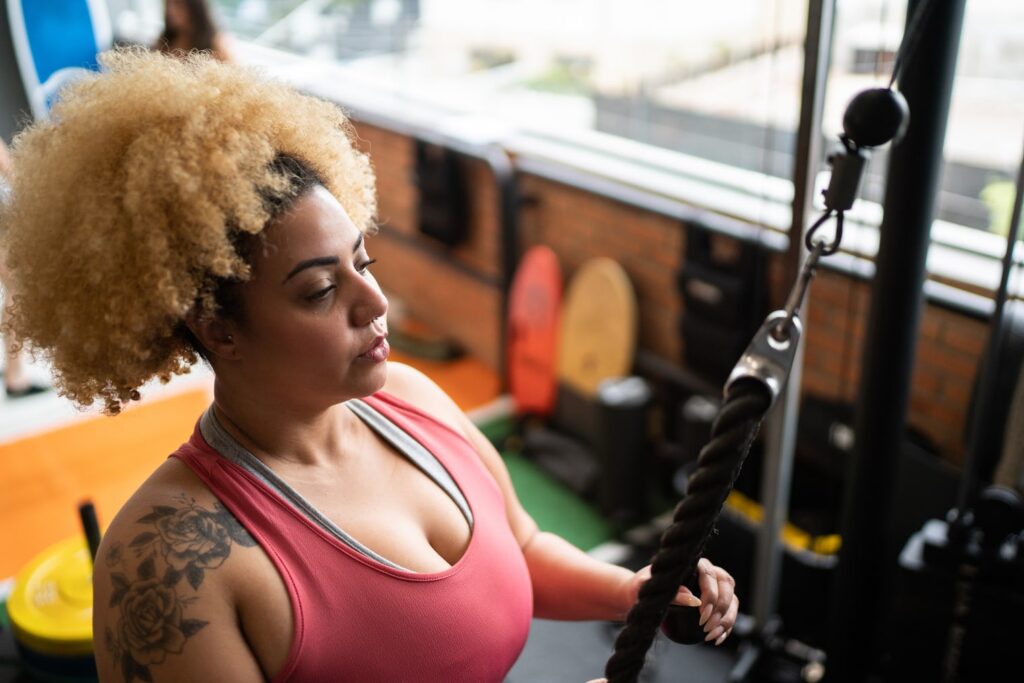
Image Courtesy: Malik Evren/E+/Getty Images

Image Courtesy: Malik Evren/E+/Getty Images
When it comes to kicking off your workout, it isn’t always clear if you should do cardio first and then lift weights, or get the lifting out of the way before jumping onto the treadmill. There are just so many factors at play, including things like how much you love (or loathe) each form of exercise, and how much time you have to work out.
It’s possible you’ve heard that it’s always best to do weights first, cardio second. But there are a million and one reasons why you might want to switch the order up. James McMillian, a NASM-certified trainer with Tone House, suggests focusing on your goals to help you decide whether to do cardio before or after weights. If you want to improve cardio endurance, for instance, then you should do your heart-pumping exercise first while you’re feeling fresh. And if your goal is to build more muscle, he recommends weight training first before you exhaust yourself doing cardio.
It’s also perfectly fine to vary your workouts by doing resistance-based work one day and cardio on the other. “Fitness is never a one-size-fits-all situation,” says Michael Ferraro, a master trainer at Studio Three. “I try to steer away from absolutes and more towards getting in touch with your own body and its needs.” With that in mind, read on for the benefits you can expect from doing cardio or weights first to help you decide.

One benefit of doing cardio first? It increases your heart rate and promotes blood flow throughout your body, says Cherie Lamb, a NASM-certified personal trainer. “These factors help the body warm up and get ready for harder work,” she tells Bustle. It’s essential to warm up your muscles to reduce the risk of strains during strength exercises, she adds, which is a good reason to do a brisk cardio routine first.
If your goal is to bang out some miles or train for a race, doing cardio first will also ensure you have better running stats because you won’t be sore or tired from lifting, says NASM-certified personal trainer Brock Davies.
He also says spiking your heart rate with cardio before lifting can help increase your metabolic rate throughout the rest of your workout. A 2021 study published in Scientific Reports found that doing cardio before weight lifting may even help boost muscle.
If you plan to do your workout in this order, go for a light run or walk for about 20 to 30 minutes, says AFAA-certified fitness instructor Alayna Curry recommends. “I would not recommend doing an hour-long HIIT, kickboxing, or cycling class before lifting weights,” she tells Bustle. HIIT increases your breathing rate for a long period of time, she says, and it can be tough to transition from that to a slower-paced strength training session. If you want more intense cardio, do it after weight lifting or save it for another day.
According to Davies, there are plenty of advantages of doing resistance training first, which is why it’s a popular recommendation. “You will be able to lift more weights, do more reps, and increase your performance by starting with lifting,” he says. By doing a quick warm-up beforehand and saving the cardio for after, you’ll find that you have more energy to lift.
“Although cardio is taxing and challenging, it’s typically able to be performed for longer periods of time without rest,” adds bande instructor Kate Havlicek. “Think of it this way: How long could you do jumping jacks for, and how long could you squat 100 pounds for?”

Strength training tends to demand a higher intensity, she says, which is why it may be best to lead with weights and devote the majority of your energy to that, and then do cardio conditioning after.
Some pros suggest doing strength training and saving cardio for another day altogether. “My typical week includes four days of strength training and two to three days of cardio — sometimes together, sometimes split on different days,” says Curry. A good combo she recommends would be an upper body-focused weight training day followed by cardio.
While there are good arguments to back up each option, remember that it all comes down to your fitness goals. Do you want to improve your cardio endurance or focus on strengthening your arms? Whichever one is most important is the one you should begin with — though you really can’t go wrong either way.
Studies referenced:
Knab AM, Shanely RA, Corbin KD, Jin F, Sha W, Nieman DC. A 45-minute vigorous exercise bout increases metabolic rate for 14 hours. Med Sci Sports Exerc. 2011 Sep;43(9):1643-8. doi: 10.1249/MSS.0b013e3182118891. PMID: 21311363.
Moberg M, Apró W, Cervenka I, Ekblom B, van Hall G, Holmberg HC, Ruas JL, Blomstrand E. High-intensity leg cycling alters the molecular response to resistance exercise in the arm muscles. Sci Rep. 2021 Mar 19;11(1):6453. doi: 10.1038/s41598-021-85733-1. PMID: 33742064; PMCID: PMC7979871.
Experts:
James McMillian, NASM-certified trainer with Tone House
Michael Ferraro, master trainer at Studio Three
Cherie Lamb, NASM-certified personal trainer
Brock Davies, NASM-certified personal trainer
Alayna Curry, AFAA-certified fitness instructor